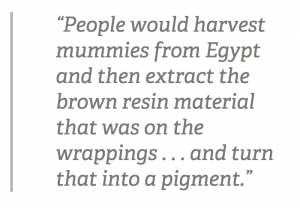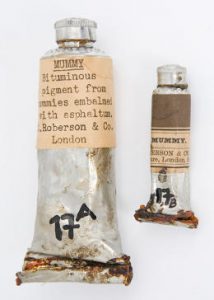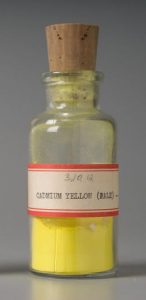Today, every color imaginable is at your fingertips. You can peruse paint swatches at hardware stores, flip through Pantone books, and fuss with the color finder that comes with most computer programs, until achieving the hue of your heart’s desire. But rewind to a few centuries ago and finding that one specific color might have meant trekking to a single mineral deposit in remote Afghanistan—as was the case with lapis lazuli, a rock prized for its brilliant blue hue, which made it more valuable than gold in medieval times.

Today, the collection is used mostly for scientific analysis, providing standard pigments to compare to unknowns. Narayan Khandekar is the director of the Straus Center for Conservation and Technical Studies at the Harvard Art Museums and the collection’s custodian. For the last 10 years, Khandekar has rebuilt the collection to include modern pigments to better analyze 20th century and contemporary art.

The way he describes his work researching and cataloging pigments is akin to detective work. “We use our instruments in the same way that forensic scientists do,” Khandekar says. “We examine and find out what we can about the key compounds that will tell us the material’s origin.” But instead of tools such as DNA analysis, he and his team of conservation scientists use techniques such as Raman spectroscopy, mass spectrometry, gas chromatography, and electron microscopy to map out the precise chemical composition of a pigment.
For example, their work was instrumental in proving that a Jackson Pollock painting “rediscovered” in 2007 was actually a fake, after pigment analysis revealed that a specific red color was manufactured 20 years after the artist’s death. The color, Red 254, was a by-product of a chemical reaction first documented in 1974; it’s also nicknamed
“Ferrari red.”
“Every pigment has its own story,” Khandekar says. With that in mind, we asked him to share the stories of 10 of the rarest and most interesting pigments in the Forbes collection.
Synthetic Ultramarine
“This was discovered in 1826 as the result of a contest. In a way it is like discovering how to make gold as artists no longer had to buy natural ultramarine at great cost.”
Mummy Brown
“People would harvest mummies from Egypt and then extract the brown resin material that was on the wrappings around the bodies and turn that into a pigment. It’s a very bizarre kind of pigment, I’ve got to say, but it was very popular in the 18th and 19th centuries.”
Brazilwood
“Brazilwood is any of several tropical trees of the senna genus. Its hard, red-color wood has had limited use for violins, bows, veneer, and high-quality furniture. The wood contains the colorant brasilin, which gives a deep-red to brownish color. Brazilwood dye has been used for textile and leather dyes, inks, paints, varnish tints, and wood stains.”
Quercitron
“A yellow vegetable dye, quercitron is extracted from the black or dark brown bark of the black oak, Quercus velutina, that is native to the Eastern and Midwestern parts of the United States.”
Annatto
“The lipstick plant—a small tree, Bixa orellana, native to Central and South America—produces annatto, a natural orange dye. Seeds from the plant are contained in a pod surrounded with a bright red pulp. Currently, annatto is used to color butter, cheese, and cosmetics.”
Lapis Lazuli
“People would mine it in Afghanistan, ship it across Europe, and it was more expensive that gold so it would have its own budget lidane on a commission.”
Dragon’s Blood
“It has a great name, but it’s not from dragons. [The bright red pigment] is from the rattan palm.”
Cochineal
“This red dye comes from squashed beetles, and it’s used in cosmetics and food.”
Cadmium Yellow
“Cadmium yellow was introduced in the mid 19th century. It’s a bright yellow that many impressionists used. Cadmium is a heavy metal, very toxic. In the early 20th century, cadmium red was introduced. You find these pigments used in industrial processes. Up until the 1970s, Lego bricks had cadmium pigment in them.”
Emerald Green
“This is made from copper acetoarsenite. We had a Van Gogh with a bright green background that was identified as emerald green. Pigments used for artists’ purposes can find their way into use in other areas as well. Emerald green was used as an insecticide, and you often see it on older wood that would be put into the ground, like railroad ties.”
[via fast co | design]






